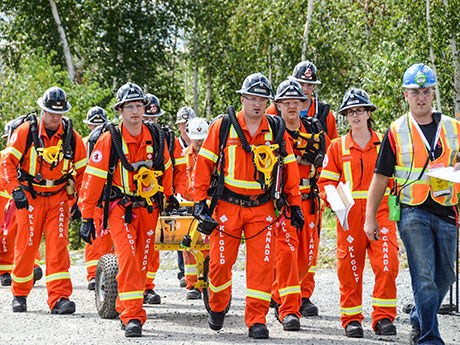Sudbury hosts International Mine Rescue Competition
The mine rescue team from Kirkland Lake Gold returned home from Sudbury with gold hard hats in recognition of their first overall finish in the 10th International Mine Rescue Competition August 19 to 26.
The Kirkland Lake team beat out 26 other teams from 13 countries, including Argentina, Australia, China, Colombia, India, Ireland, Poland, Russia, Slovakia, the U.K., the U.S. and Vietnam. Finishing second and third were the Boliden Tara Mines team from Ireland and the KGHM White Eagles from Poland.
The teams showed off their firefighting, first aid and high angle rope rescue skills, participated in an emergency underground simulation and competed in theory and technical competence events.
Seven Canadian teams representing mines in Saskatchewan, Manitoba, Ontario and Quebec participated in the competition.
“We did try to make it fair, but Canadian teams did extremely well despite our best efforts to handicap them,” said Ted Hanley, general manager of Ontario Mine Rescue.
The Compass Minerals’ Goderich Mine team placed second in the emergency underground simulation behind first place Kirkland Lake Gold and first in the theory event. The Cameco McArthur River team finished third in the firefighting and first aid events and second in the high angle rope rescue competition. And the hometown Vale Sudbury West Mines team came in third in both the high angle rope rescue and theory events.
Other winners included Boliden Tara Mines (third place in the emergency underground simulation), the Bytom team from Poland (first in firefighting), the U.S. MSHA Mine Energy team (second in firefighting, third in the technician event), the Peabody Energy Wambo Coal team from Australia (top honours in First Aid), the KGHM White Eagles from Poland (first in high angle rope rescue), the Goldcorp Americas team (second place in theory), the EMERCOM team from Russia (first in theory) and the Shanxi Coal and Chemical Group team from China (second in the theory event).
This was the first time the biennial international competition has been held in Canada since its establishment in 1998.
Ontario Mine Rescue: a proud history
Speaking at a CIM Sudbury membership meeting September 15th, Ted Hanley, general manager of Ontario Mine Rescue, traced the origin of mine rescue to catastrophic mine disasters in the late 19th and early 20th centuries.On March 10, 1906, 1,099 workers perished in the Courrrières coal mine disaster in France, and between 1907 and 1909, three disasters in West Virginia, Pennsylvania and Illinois resulted in the death of close to 1,000 miners, prompting the U.S. Bureau of Mines to introduce standards for mine rescue.
[frame src="https://vmcdn.ca/files/sms/import/2016/11/Ted-Hanley.jpg" width="200" height="345" align="left" linkstyle="normal" title="Ted Hanley, general manager, Ontario Mine Rescue"]“In Ontario, our history started in 1928 following a tragic event at the Hollinger Mine in Timmins,” said Hanley. Thirty-nine miners succumbed to carbon monoxide poisoning as a result of a fire in an open excavation on the 550-foot level of the mine. “We realized we didn’t have the equipment, the people or the training to access trapped miners during long duration mine emergencies. That prompted the creation of the Ontario Mine Rescue program in 1929.”
“About every 20 years following that, there was a paradigm shift or a major emergency that led to an improvement of the program,” said Hanley.
A mine disaster in 1947 at the East Malartic Mine in Quebec underlined the need for standardized training when teams responding from different jurisdictions realized they didn’t have the same equipment and training. In 1965, a fire at the McIntyre Mine in Timmins highlighted the need for longer duration breathing apparatus, and in 1985, said Hanley, “we began dealing with serious rockburst emergencies which expanded the mandate of Ontario Mine Rescue to include non-fire emergencies.”
Today, Ontario Mine Rescue boasts approximately 900 volunteers, co-ordinators and emergency response managers in eight districts across the province. Each underground mine has a substation equipped with breathing apparatus, gas sensors, first aid kits, and firefighting and high angle rope rescue equipment.
“The goal is to have the correct number of trained volunteers and equipment at each mine so that when an emergency occurs, there can be a rapid response from the volunteer mine rescuers at the site,” said Hanley.
There are also mine rescue stations strategically located around the province, including two in Sudbury, as well as mine rescue officers who provide training and advisory services.
Ontario Mine Rescue is part of Workplace Safety North and has a staff of 14 to 17 people, but it’s the mine operators themselves and the 900 plus volunteers who do the heavy lifting.
“Operators are responsible for drafting the emergency response plans,” said Hanley. “They establish the roster of mine rescue personnel, persuade employees to volunteer, maintain the sub-stations and form the control group that is in charge of an emergency.”
To keep mine rescuers sharp, there is extensive training and annual competitions, both at the district and provincial levels.
Ontario Mine Rescue is always on the lookout for new technology. Tablets, for example, are being introduced for use by team captains and briefing officers to replace pen and paper recording.
“Captains will take the tablets underground, while briefing officers on surface will have a laptop or tablet,” said Tim Ebbinghaus, emergency services specialist. “If the captain records something or takes a picture, the control group on surface will see it immediately.”
Twenty teams at the International Mine Rescue Competition were provided with tablets for the emergency underground simulation at Vale’s 144 Orebody, which is equipped with mine-wide WiFi.
New masks from Dräger Canada with integrated two-way communication are also being introduced.
Last year, a total of 36 Ontario Mine Rescue teams responded to 12 fires and nine other emergencies.


